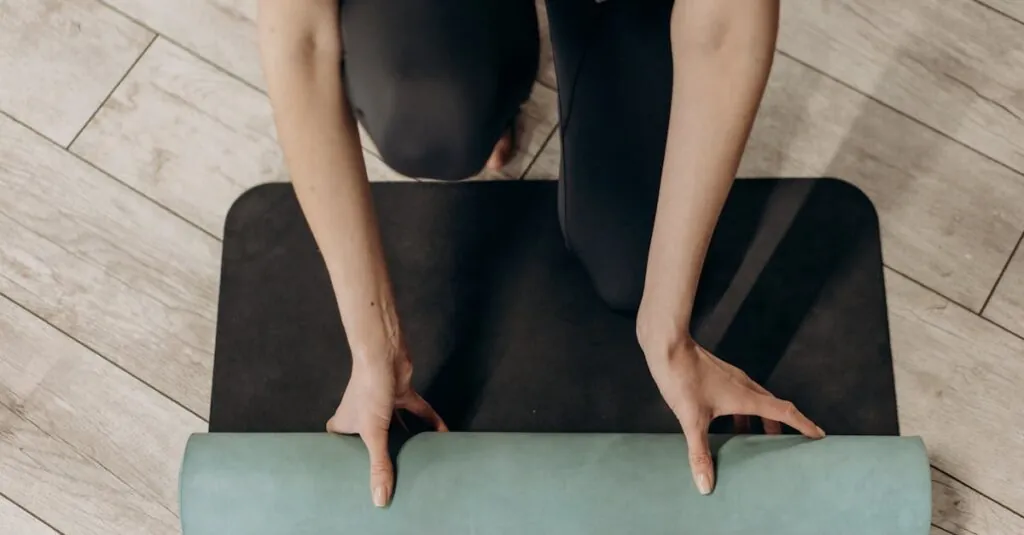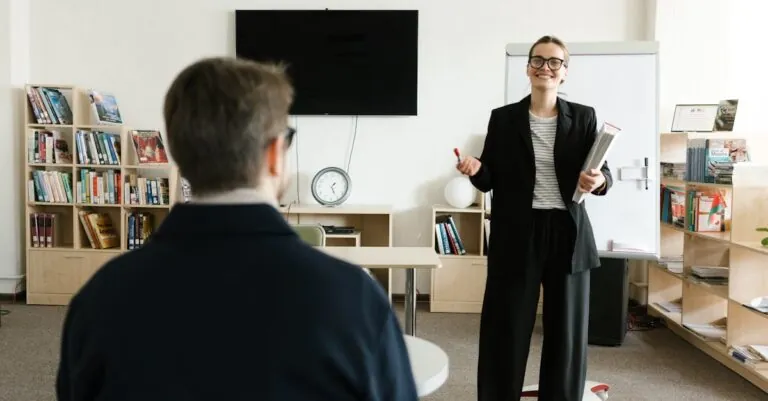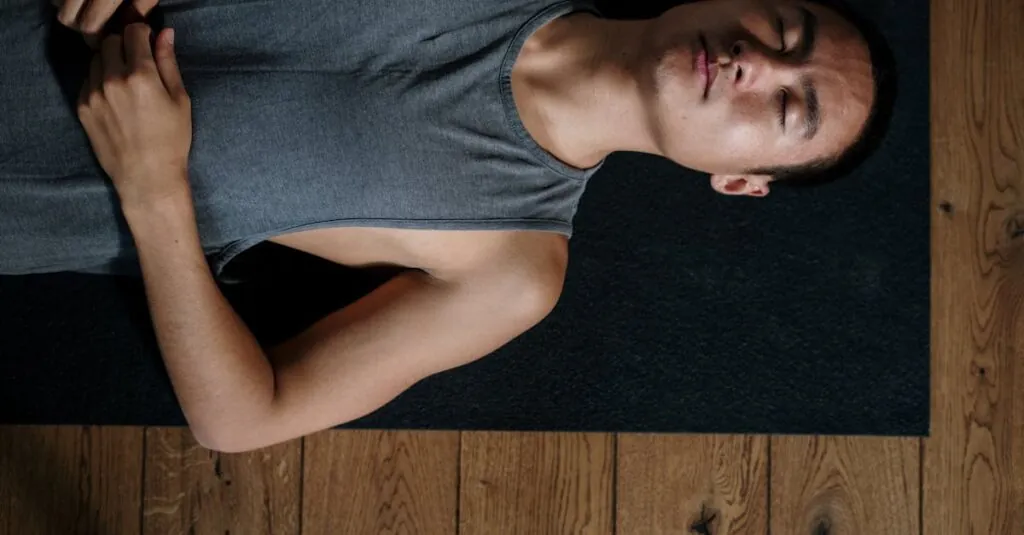In today’s fast-paced world, finding time to unwind can feel like searching for a unicorn in a haystack. With deadlines looming and to-do lists multiplying, it’s no wonder stress levels are skyrocketing. But fear not—crafting a relaxation routine can transform chaos into calm, turning those frazzled moments into blissful escapes.
Imagine sinking into a cozy chair with a cup of herbal tea, or perhaps indulging in a few minutes of deep breathing while your favorite playlist serenades you. A well-designed relaxation routine not only rejuvenates the mind but also boosts productivity and creativity. So why not swap that frantic energy for a sprinkle of serenity? After all, if relaxation were a sport, it’d be the gold medalist of self-care! Let’s dive into the art of unwinding and discover how to make relaxation an essential part of daily life.
Table of Contents
ToggleUnderstanding Relaxation Routine
A relaxation routine serves as a powerful tool to manage stress and enhance well-being. By integrating specific practices into daily life, individuals can foster an environment conducive to peace and mindfulness.
Importance of Relaxation
Relaxation plays a crucial role in mental and physical health. Stress, if unmanaged, can lead to various health issues, including anxiety and fatigue. Allocating time for relaxation allows the body to recover and rejuvenate. Engaging in mindful activities, such as deep breathing or meditation, nurtures emotional stability. Research shows that consistent relaxation reduces stress hormones, improving overall life quality.
Benefits of a Routine
Establishing a routine cultivates predictability and security. With daily relaxation practices, individuals develop stronger coping mechanisms for stressors. Routines enhance productivity by clearing mental clutter, allowing for more focus on tasks. Activities like yoga or journaling create a sense of accomplishment, reinforcing positive habits. Moreover, a structured relaxation routine can elevate mood and increase energy levels. Prioritizing relaxation ultimately leads to a more balanced lifestyle.
Key Elements of a Relaxation Routine
Establishing a relaxation routine involves integrating various elements that promote peace and mindfulness. Incorporating specific practices ensures a well-rounded approach to relaxation.
Mindfulness Practices
Mindfulness practices cultivate present-moment awareness. Meditation acts as a cornerstone; it encourages deep breathing and focused attention. Guided imagery allows the mind to visualize serene settings, enhancing emotional well-being. Journaling serves as another valuable activity; it helps process thoughts and feelings, leading to clarity. Engaging in mindful eating fosters appreciation for food and promotes healthier habits. Practicing gratitude contributes positively to mental health by shifting focus towards appreciation. Incorporating these activities nurtures an environment that fosters relaxation and minimizes stress over time.
Physical Techniques
Physical techniques play a critical role in a relaxation routine. Stretching alleviates muscle tension, promoting overall physical comfort. Yoga combines movement with breath, enhancing flexibility and calming the mind. Progressive muscle relaxation systematically releases tension from different body parts, encouraging a deeper state of relaxation. Deep breathing exercises lower heart rates and reduce anxiety levels effectively. Engaging in regular physical activity boosts mood and releases endorphins, contributing to overall well-being. Prioritizing these techniques can lead to significant improvements in stress management and physical health.
Creating Your Relaxation Routine
Creating a relaxation routine requires a clear understanding of personal needs and effective time management strategies. Individuals must tailor their approaches to optimize the benefits.
Identifying Your Needs
Recognizing individual stressors plays a vital role in establishing a routine. Each person’s preferences for relaxation differ significantly. Some may find solace in quiet meditation, while others may benefit from engaging yoga sessions. Prioritizing these personal needs ensures the routine remains effective and enjoyable. Consider journaling to articulate feelings or practicing gratitude to enhance emotional resilience. Evaluating what brings peace and joy aids in crafting a personalized routine that effectively addresses unique stressors.
Time Management Strategies
Effective time management enhances relaxation experiences. Scheduling specific times for relaxation within daily routines creates a sense of commitment. Setting reminders for dedicated breaks contributes to consistency. Allocating at least 10 to 15 minutes each day can significantly improve mental clarity. Embracing the practice of prioritizing relaxation can lead to increased productivity in other areas. Using tools like calendars or to-do lists helps in visualizing tasks and incorporating relaxation smoothly into busy schedules. Balancing work responsibilities with relaxation time nurtures a more harmonious lifestyle.
Tips for Maintaining Consistency
Establishing a successful relaxation routine requires commitment and strategy. Prioritize key aspects to foster consistency in daily practice.
Setting Realistic Goals
Creating achievable goals plays a crucial role in sustaining a relaxation routine. Individuals should start with small, specific objectives, such as dedicating ten minutes daily to deep breathing or meditation. Gradually increasing these goals fosters a sense of accomplishment and motivation. Balancing relaxation practices with other life responsibilities ensures time constraints do not hinder progress. Recognizing personal limitations and preferences also helps in curating a routine that feels enjoyable rather than burdensome. Incorporating variety can prevent boredom; try different relaxation techniques like yoga or guided imagery on alternating days.
Tracking Progress
Monitoring progress reinforces the habit of relaxation. Keeping a journal marks achievements and highlights areas that require attention. Individuals can note the duration and outcomes of each relaxation session, fostering accountability. Using tools like apps or stickers for tracking relaxation days encourages engagement. Celebrating milestones, whether reaching consistent daily practice or trying a new technique, cultivates motivation. Reviewing progress regularly also identifies what works best, allowing for adjustments if needed. Emphasizing this reflective practice strengthens the overall routine and enhances the sense of achievement in one’s relaxation journey.
Embracing a relaxation routine is essential for navigating today’s fast-paced world. By prioritizing moments of calm individuals can significantly enhance their mental and physical well-being. Simple practices like deep breathing and mindful activities not only alleviate stress but also foster a greater sense of clarity and focus.
Establishing a personalized routine allows for flexibility while addressing unique needs. Regularly incorporating relaxation into daily life cultivates resilience and promotes emotional stability. As individuals commit to their relaxation journeys they’ll likely find increased energy and improved moods.
Ultimately the journey to a more balanced lifestyle starts with recognizing the importance of relaxation. By making it a priority people can transform their lives one peaceful moment at a time.








